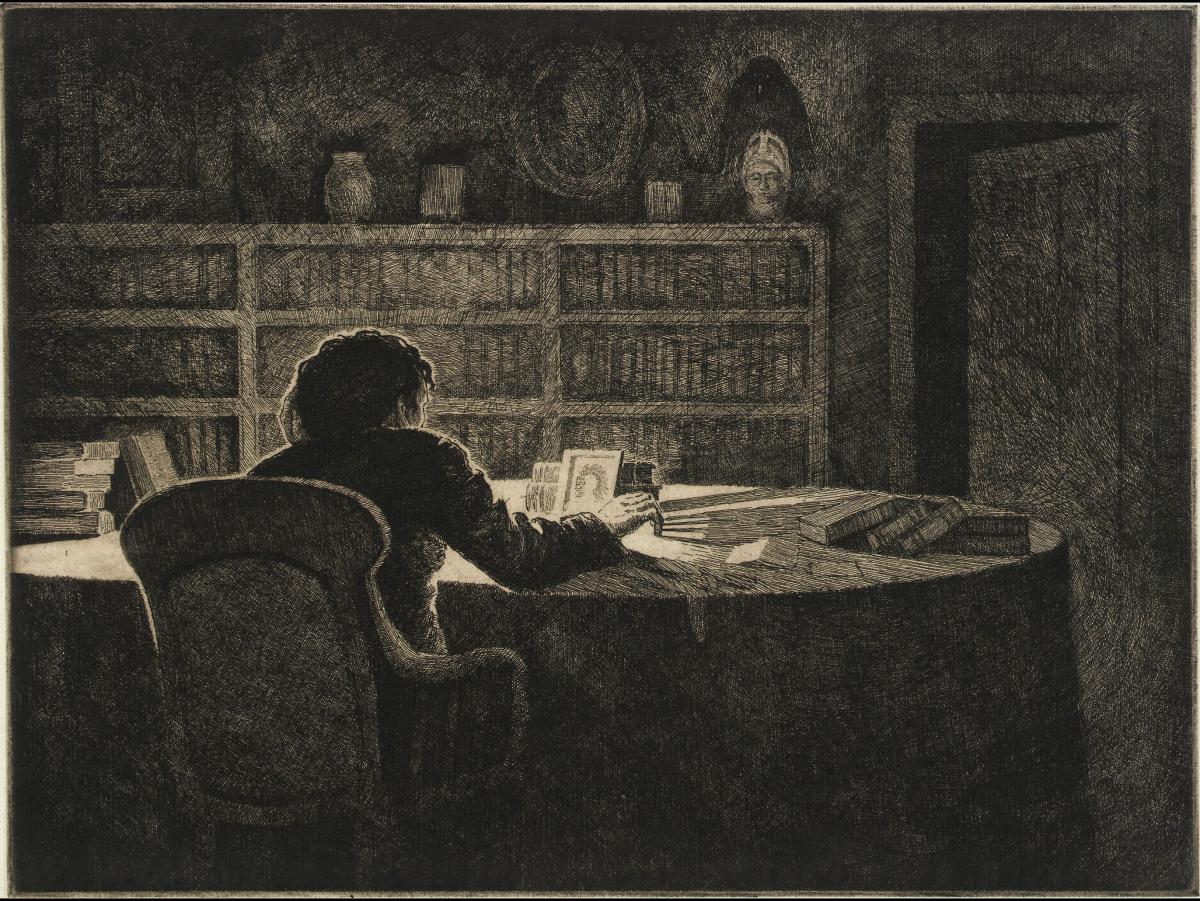This etching of darker shades of markings creating a depiction of a scene from Edgar Allan Poe's The Raven appears to be a fitting closing entry to this American gallery. The narrator depicted in an illustrated form of Poe sits in his chair at a dimly lit table at night, seeming to be intently focused on something as the viewer can only view the back of his head and torso. In the background, the door to his chamber is cracked open as the raven sits almost ominously on top of a bust of Pallas directly the left of the door. This etching conveys a dark, dreary, and cheerless mood. It is as if the sole light on the table is the only source of joy or hope left as if it is like a memory in a time of darkness. This work of art from George Bradshaw forces the viewer to admit that everyone must accept death of a thing, time, or person in their life, and the result of the rebirth from that death relies on human choice. If one chooses to accept it and embrace or create something new moving forward, then a signficiant and life-changing event can arise from the ashes, much like the other gallery entries have proved. However, both this etching and the text of The Raven shows the grim and bitter rebirth that occurs to everyone--not just Americans--who fail to move on from the past.
The focus of The Raven is partly on the narrator's obsession with his lost love, Lenore, and how he copes with it through his intense near-monologue with the personified raven that flew into his chamber. Poe writes, "I scarcely more than muttered: “Other friends have flown before— /On the morrow he will leave me, as my Hopes have flown before" (Poe). Here, the narrator reflects on the hopes of life that were shattered by the passing of his beloved, and now he wonders if the raven of gloom and despair will leave him like the antithesis of these feelings, which is, again, hope. Also, right before the end of the poem, the narrator grows even more frustrated, and the reader can witness then his breaking point where he chooses a future of despair and hearbreak: "Leave my loneliness unbroken!—quit the bust above my door! /Take thy beak from out my heart, and take thy form from off my door!” (Poe). When the raven arrives, the narrator keeps peppering the bird with questions about Lenore until he grows continually frustrated with the response "nevermore;" by the end of the work, the narrator is crushed by sadness from which his soul will never rise again (Sarikas). Another critical analyzer of this work by Poe also writes on how the language can suck a student or other reader into the orbit of shadow from which the narrator can never be lifted up ( Freedman 27). This is another warning that the thoughts of grief from another's emotionally compelling work can make a susceptible reader reap a dispairing future from the death of the old in their life. From the death of the narrator's hopes, he chooses to accept his grief here as his future.
Works Cited
Bradshaw, George A. “The Raven.” Smithsonian American Art Museum, americanart.si.edu/artwork/raven-2723.
Freedman, William. “Poe’s ‘Raven’: The Word That Is an Answer ‘Nevermore.’” Poe Studies/Dark Romanticism, vol. 31, no. 1/2, 1998, pp. 23–31. JSTOR, http://www.jstor.org/stable/45297334.
Poe, Edgar Allan. “The Raven.” Gutenberg.Org, 1 Oct. 1997, https://www.gutenberg.org/files/1065/1065-h/1065-h.htm.
Sarikas, Christine. “Understanding The Raven: Expert Poem Analysis.” PrepScholar.Com, blog.prepscholar.com/the-raven-poem-summary#:~:text=Poe%20stated%20that%20the%20raven,tone%20of%20the%20poem%20better.


